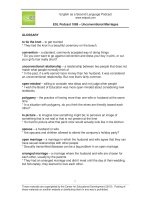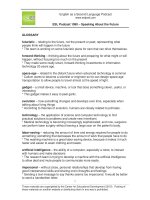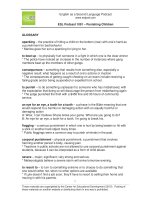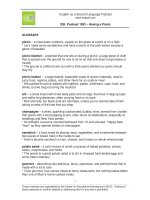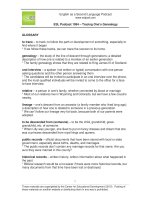ESLPod 1117 guide Want to be Fluent in English?
Bạn đang xem bản rút gọn của tài liệu. Xem và tải ngay bản đầy đủ của tài liệu tại đây (91.33 KB, 9 trang )
English as a Second Language Podcast
www.eslpod.com
ESL Podcast 1117 – Assembling Furniture
GLOSSARY
nightstand – a small table with drawers placed next to a bed, usually to hold a
lamp, clock, and a glass of water
* Before going to sleep each night, I put my glasses on the nightstand.
assembly – putting together pieces intended to fit with the others to create an
object
* The store keeps prices low by requiring customers to do their own assembly,
rather than having employees put everything together.
diagram – a drawing, perhaps with a few words, that shows how something
works or how something should be put together
* This diagram illustrates how a simple electric circuit works.
to fit together – to be placed next to each other and joined so that they are
connected
* How long did it take you to fit together all the puzzle pieces?
part – a piece; a component of a larger machine or object
* This toy has small parts and may be dangerous for young children.
particleboard – a cheap material made by compressing (pushing tightly
together) many small pieces of wood, used as a substitute for more expensive,
solid wood
* This bookcase is made from particleboard, so it must be painted because the
surface doesn’t look very good otherwise.
plywood – a wooden board made from layers that are glued together
* Plywood is strong, but not as beautiful as real, solid wood.
design flaw – a mistake in the way that something was conceived and created,
so that it cannot work as intended
* The engineers discovered a design flaw when they realized that the gas pedal
would hit the brake pedal when pressed all the way down.
nail – a straight long piece of metal with a pointed end, hit with a hammer to go
through two or more layers to connect them
* Do we have enough nails to put up six shelves on this wall?
bent – not straight; crooked
* The spoon is bent from when we tried to use it to scoop ice cream.
1
These materials are copyrighted by the Center for Educational Development (2015). Posting of
these materials on another website or distributing them in any way is prohibited.
English as a Second Language Podcast
www.eslpod.com
ESL Podcast 1117 – Assembling Furniture
screw – a long piece of metal that has a spiral pattern around it, with a flat top
that has a groove (long, narrow deep line), so that a screwdriver can be inserted
into it and it can be turned and pushed into another object to connect two things
* To change the battery, you’ll need to remove this screw and open the case.
defective – not working properly; with an imperfection or problem
* This cell phone is defective. It won’t make or receive calls.
Allen wrench – a small, L-shaped metal tool with a hexagon (six-sided shape) at
each end, used to turn screws with that same shape
* You’ll need an Allen wrench to attach the bike rack to the car.
hammer – a heavy tool with a wooden handle and a metal piece at one end,
used to hit nails and push them into wood
* Lyle screamed in pain when he accidentally hit his thumb with his hammer.
screwdriver – a tools with a plastic handle and a long metal piece that has a flat
or x-shaped end, used to twist and push screws
* Do you have a really small screwdriver that I can use to fix my glasses?
drill – an electric tool that puts a small hole into a wall or a piece of wood, usually
used to create room for a screw
* Use the drill to create small holes in the wall where you want to hang the shelf,
and then it will be easier to insert the screws.
duct tape – very strong, thick tape with one sticky side, traditionally used to
connect ducts (passageways for heated or cooled air), but now often used to
inexpensively fix many things
* When the window broke, they sealed it with cardboard and duct tape.
2
These materials are copyrighted by the Center for Educational Development (2015). Posting of
these materials on another website or distributing them in any way is prohibited.
English as a Second Language Podcast
www.eslpod.com
ESL Podcast 1117 – Assembling Furniture
COMPREHENSION QUESTIONS
1. What does Armand mean when he says, “It’s mainly made of particleboard
and plywood.”
a) It’s made of plastic.
b) It’s made of low-quality wood.
c) It’s made of unpainted wood.
2.
a)
b)
c)
What is wrong with the nails?
They are too short.
They are too long.
They are not straight.
______________
WHAT ELSE DOES IT MEAN?
part
The word “part,” in this podcast, means a piece or component: “The mechanic
had to order a special part to repair the old car.” When talking about theater, a
“part” is a role or a character in a performance: “Jenna was thrilled to get the part
of Genevieve in Camelot.” The phrase “to look the part” means to have the
expected appearance of someone or something: “Dressed in black leather and
heavy chains, Clark certainly looks the part of a motorcycle owner.” When talking
about hair, a “part” is the line of skin seen on the head that divides hair so it falls
in different directions: “Pierre has always had his part on the left.” Finally, the
phrase “in these parts” means in a particular area, especially a rural area: “We
don’t see many tourists in these parts.”
bent
In this podcast, the word “bent” means crooked, or not straight: “Michael’s nose
is bent from when he broke it years ago.” The phrase “bent out of shape” means
very angry: “Were your parents really bent out of shape when you took their car
without permission?” The phrase “bent on doing (something)” means determined
to do something: “The management team is bent on expanding into the
northeast, even though our financial projections don’t support it.” The phrase
“hell-bent” means very determined to do something, especially if it is unpopular:
“Greg is hell-bent on joining the army as soon as he finishes high school, even
though his parents want him to join the family business.” Finally, a “bent” can
refer to one’s interests and talents: “She has an artistic bent and enjoys painting
and sculpting.”
3
These materials are copyrighted by the Center for Educational Development (2015). Posting of
these materials on another website or distributing them in any way is prohibited.
English as a Second Language Podcast
www.eslpod.com
ESL Podcast 1117 – Assembling Furniture
CULTURE NOTE
Buying Used Furniture
People who don’t want to pay “full price” (the price being charged for a new item
in a store) have many options for buying “used” (already used by someone else)
furniture. Many people who want to “upgrade” (get something nicer) their
furniture are happy to sell their “cast-offs” (things that one no longer wants or
needs) to others. Traditionally, people listed items for sale in the “classified ads”
(section of the newspaper with many small text ads), but now, online classifieds
like Craiglist have become more popular.
“Secondhand stores” specialize in selling used items. Many of them work “on
consignment,” agreeing to “show” (allow potential buyers to see) used furniture in
their store and paying the seller a percentage of the final selling price. Other
secondhand stores buy items directly from sellers and then resell them to other
buyers. Nicer items and especially “antiques” (old objects that are very valuable)
are often sold at “auctions” where people “bid” (state how much they would be
willing to pay) and compete against each other to buy the items.
Sometimes people try to sell their used furniture at a “garage sale” (a sales event
where people sell old items in front of their home; see ESL Podcast 277). Items
that aren’t sold during the garage sale might be “given away” (let someone else
have something without requesting payment) to friends or “donated” (giving
away) pieces to nonprofit organizations that “operate” (run) “thrift stores” where
items are sold at very low prices. But usually, the used furniture at thrift stores is
“out of style” (no longer fashionable) and has “cosmetic damage” (is blemished;
has problems with its appearance).
______________
Comprehension Questions Correct Answers: 1 – b; 2 – c
4
These materials are copyrighted by the Center for Educational Development (2015). Posting of
these materials on another website or distributing them in any way is prohibited.
English as a Second Language Podcast
www.eslpod.com
ESL Podcast 1117 – Assembling Furniture
COMPLETE TRANSCRIPT
Welcome to English as a Second Language Podcast number 1,117 –
Assembling Furniture.
This is English as a Second Language Podcast episode 1,117. I’m your host, Dr.
Jeff McQuillan, coming to you from the Center for Educational Development in
beautiful Los Angeles, California.
Visit our website at ESLPod.com. Take a look at our ESL Podcast Store. If you
need more Business or Daily English, our ESL Podcast Store is the place to buy
some Special Courses on those topics. Oh, and they’re good too.
On this episode, we listen to a dialogue between Armand and Suzanne about
assembling, or putting together, furniture. Let’s get started.
[start of dialogue]
Armand: Did you know that this nightstand required assembly when you bought
it?
Suzanne: The box said that it required simple assembly. I guess what’s simple to
them isn’t simple to us.
Armand: You can say that again. These instructions aren’t in English, there are
no diagrams showing how the parts fit together, and we seem to be missing
parts. I also question the quality. It’s mainly made of particleboard and plywood.
Do you think we should return it?
Suzanne: No, let’s just keep it and do the best we can.
Armand: That’s hard to do when there seems to be a design flaw with the
drawers. The pieces don’t fit together as they should. These nails are also bent
and these screws look defective.
Suzanne: It’s not looking good, is it? I also bought this because I thought
everything could be assembled using Allen wrenches, but it looks like we’ll
actually need a hammer, screwdriver, and maybe a drill.
Armand: Well, let’s see what we can do. If we don’t have the right tools or parts, I
have a solution.
5
These materials are copyrighted by the Center for Educational Development (2015). Posting of
these materials on another website or distributing them in any way is prohibited.
English as a Second Language Podcast
www.eslpod.com
ESL Podcast 1117 – Assembling Furniture
Suzanne: What?
Armand: Duct tape.
[end of dialogue]
Armand begins our dialogue by asking Suzanne, “Did you know that this
nightstand required assembly when you bought it?” A “nightstand” (nightstand) –
one word – is a small table that you put next to your bed, usually to put a lamp, a
clock, and perhaps a glass of water on. A nightstand usually also has what we
call “drawers” – little boxes that pull out from the table that you can put things in
and then slide back into the table.
Armand is asking Suzanne if she knew before she bought it “that this nightstand
required assembly.” “Assembly” (assembly) is the noun form of the verb “to
assemble” (assemble). “To assemble” means to put something together – to take
individual pieces and to put them together to make something else. Nowadays
it’s popular for some stores to sell furniture (things you put in your house such as
tables, chairs, and perhaps nightstands) “unassembled” – that is, they’re not put
together. You have to basically build or put the piece of furniture together
yourself.
One popular store here in the U.S. and in many other countries is IKEA, a
Swedish company. You can buy furniture, but usually you have to assemble it
yourself. And boy, if you’ve ever assembled something from IKEA, you know it’s
not as easy as it looks. It’s not as easy as it appears. Anyway, Armand is not
very happy, I think, with Suzanne, because he has to assemble this nightstand.
Suzanne says, “The box said” (the cardboard container that it came in is called a
box) “that it required simple assembly.” “Simple assembly” would be not very
complicated – maybe three or four pieces, say. She continues, “I guess what’s
simple to them isn’t simple to us.” The company thinks it’s simple, but you don’t
think it’s simple. Armand says, “You can say that again.” That expression “You
can say that again” is when someone says something that you agree with and
you want to emphasize that you really agree with that person.
Armand says, “These instructions aren’t in English. There are no diagrams
showing how the parts fit together, and we seem to be missing parts.” So, the
instructions – the information that tells you how to assemble the furniture – aren’t
in English for this particular nightstand, according to Armand. He also says there
are “no diagrams showing how the parts fit together.” A “diagram” (diagram) is a
6
These materials are copyrighted by the Center for Educational Development (2015). Posting of
these materials on another website or distributing them in any way is prohibited.
English as a Second Language Podcast
www.eslpod.com
ESL Podcast 1117 – Assembling Furniture
drawing that shows you how something works or how something should be put
together.
“To fit together” means to be placed next to each other and joined so that they
are connected. If you are assembling a table, the legs would fit together with the
table top. They would be connected to each other. However, Armand says that
they “seem to be missing parts.” A “part” (part) here is a piece – in this case, a
piece of the nightstand. “I also question the quality,” Armand says. “To question”
here means to doubt, or to have doubts about something.
Armand says, “It’s mainly made of particleboard and plywood.” “Particleboard” is
a cheap, inexpensive material made by compressing, or putting together, many
smaller pieces of wood. Sometimes companies sell furniture made of
particleboard because it’s cheaper. Another cheap form of wood is called
“plywood” (plywood). Plywood is a wooden board made from layers of wood that
are glued together – they’re stuck together. Plywood is usually very thin.
Some people use plywood on the walls. They put the plywood up, up on the
walls. This was very popular in the 1960s, in the 1970s. Instead of painting your
wall or putting wallpaper on it, you could put pieces of wood on it called plywood.
My house where I grew up had plywood in several of the rooms because my
father didn’t want to paint the rooms every couple of years. So, we had this
brown plywood on the walls. It was quite normal during the 1970s, or at least it
was in the neighborhood where I grew up.
Armand asks Suzanne if perhaps they should “return” this nightstand, meaning
bring it back to the store and get their money back. Suzanne says, “No, let’s just
keep it and do the best we can.” Armand says, “That’s hard to do when there
seems to be a design flaw with the drawers.” A “design (design) flaw (flaw)” is a
mistake in the way that something was conceived or created. It’s a mistake in the
basic idea behind, in this case, the nightstand. Armand says there’s a design flaw
with the drawers of the nightstand. “The pieces don’t fit together as they should,”
he says.
“These nails are also bent and these screws look defective,” says Armand.
“Nails” (nails) are straight long pieces of metal with pointed ends that you use to
put two things together. I say they’re long, but I mean really they’re perhaps
between a quarter of an inch and an inch or two inches. “Nails” are used usually
to put together pieces of wood, although you can use a nail to connect or to join
two other kinds of material as well. Armand says that the nails that came with this
nightstand are “bent” (bent). “Bent” here means not straight. Another word we
would use is “crooked” (crooked).
7
These materials are copyrighted by the Center for Educational Development (2015). Posting of
these materials on another website or distributing them in any way is prohibited.
English as a Second Language Podcast
www.eslpod.com
ESL Podcast 1117 – Assembling Furniture
Armand also says, “These screws look defective.” A “screw” (screw) here means
a long piece of metal, about the size of a nail, that has a spiral pattern around it.
A screw is not pounded in with a hammer as you would a nail. A screw is put into
a piece of wood or a piece of metal using something called a “screwdriver.” It
turns in order to go into the material. You don’t hit it. You turn it with a
screwdriver. “Defective” (defective) means it doesn’t work properly. It has a
problem.
Suzanne says, “It’s not looking good, is it?” meaning it doesn’t look like this
nightstand is going to be one that they want to keep. She says, “I also bought this
because I thought everything could be assembled using Allen wrenches.” An
“Allen wrench” (wrench) is a small tool that is in the shape of the letter L. It’s a
metal tool that has a six-sided shape at the end of it, what we call a “hexagon,”
and it’s used to turn special kinds of screws that require this special kind of
wrench. The screws themselves have a hole that is six-sided.
Suzanne says, “It looks like we actually need a hammer, screwdriver, and maybe
a drill. A “hammer” (hammer) is a heavy tool that you use to pound nails into a
piece of wood or other material. A “screwdriver” is a long piece of metal that is
used to twist or turn screws so that the screw goes into the material. A “drill”
(drill) is an electric tool that is often used instead of a screwdriver to put material
into a piece of wood or metal.
Armand says, “Well, let’s see what we can do. If we don’t have the right tools or
parts, I have a solution.” Suzanne says, “What?” Armand says, “Duct tape.”
“Duct tape” (duct tape) is a very strong, thick tape that is usually grey in color and
nowadays is used to connect two different things together that perhaps are
broken or that you don’t have another way of connecting or keeping together.
People use duct tape nowadays all the time to cover a hole in something or to fix
something that has broken. It’s a very strong tape that can be quite useful when
something breaks or when you don’t have a way of binding two things together
with normal tape.
Now let’s listen to the dialogue, this time at a normal speed.
[start of dialogue]
Armand: Did you know that this nightstand required assembly when you bought
it?
8
These materials are copyrighted by the Center for Educational Development (2015). Posting of
these materials on another website or distributing them in any way is prohibited.
English as a Second Language Podcast
www.eslpod.com
ESL Podcast 1117 – Assembling Furniture
Suzanne: The box said that it required simple assembly. I guess what’s simple to
them isn’t simple to us.
Armand: You can say that again. These instructions aren’t in English, there are
no diagrams showing how the parts fit together, and we seem to be missing
parts. I also question the quality. It’s mainly made of particleboard and plywood.
Do you think we should return it?
Suzanne: No, let’s just keep it and do the best we can.
Armand: That’s hard to do when there seems to be a design flaw with the
drawers. The pieces don’t fit together as they should. These nails are also bent
and these screws look defective.
Suzanne: It’s not looking good, is it? I also bought this because I thought
everything could be assembled using Allen wrenches, but it looks like we’ll
actually need a hammer, screwdriver, and maybe a drill.
Armand: Well, let’s see what we can do. If we don’t have the right tools or parts, I
have a solution.
Suzanne: What?
Armand: Duct tape.
[end of dialogue]
Our dialogue today was assembled by the wonderful scriptwriter, Dr. Lucy Tse.
From Los Angeles, California, I’m Jeff McQuillan. Thank you for listening. Come
back and listen to us again right here on ESL Podcast.
English as a Second Language Podcast was written and produced by Dr. Lucy
Tse, hosted by Dr. Jeff McQuillan. Copyright 2015 by the Center for Educational
Development.
9
These materials are copyrighted by the Center for Educational Development (2015). Posting of
these materials on another website or distributing them in any way is prohibited.
